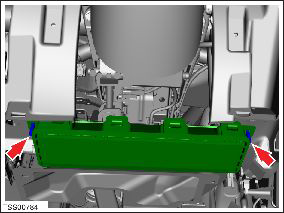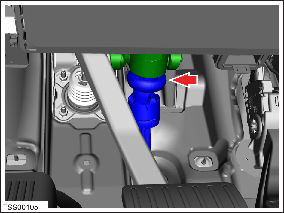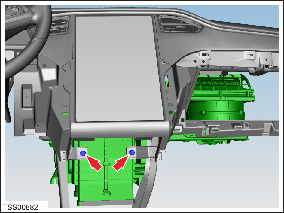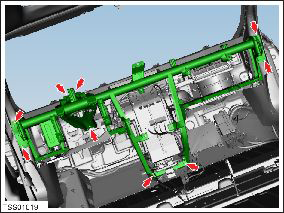Tesla Model S: Cross Car Beam (Remove and Replace)
Tesla Model S (2012-2025) Service Manual / Instrument Panels and Pedals / Cross Car Beam (Remove and Replace)
Removal
- Remove the IP carrier (refer to procedure).
- Remove the center console (refer to procedure).
- Remove the nuts (x2) that secure the driver knee airbag. Retain
the washers (x2). Disconnect the harness connector and remove the
airbag from the vehicle (torque 10.5 Nm).

- Remove the nuts (x2) that secure the passenger knee airbag. Disconnect the harness connector and remove the airbag from the vehicle (torque 10.5 Nm).
- Remove the bolt that secures the steering column to the
intermediate shaft joint (torque 33 Nm).

- Carefully remove the steering wheel and column assembly. Caution: To prevent damage, do not allow the steering wheel and column assembly to rotate while it is removed.
- Remove the bolts (x2) that secure the HVAC assembly to the cross
car beam (torque 10 Nm).

- Remove the bolts (x9) that secure the cross car beam to the body (torque 27 Nm).
- Release the cross car beam from the body and retain the spacer from between the LH 'A' post and the cross car beam.
- Remove the cross car beam.

Installation procedure is the reverse of removal.
READ NEXT:
 Assembly - Frame - Instrument Cluster (Remove and Replace)
Assembly - Frame - Instrument Cluster (Remove and Replace)
Removal
Remove driver side lower dash trim (refer to procedure)
Remove the instrument panel side covers (refer to procedure)
Remove the A-pillar middle trim panels (refer to proce
 Trim - Touch Screen Surround (Remove and Replace)
Trim - Touch Screen Surround (Remove and Replace)
Removal
Remove the MCU/touch screen (refer to procedure).
Remove the screws (x6) that secure the touch screen surround
(torque 4 Nm).
Cut the cable tie that secures the Bluetooth
 Face Level Vent - Driver's - Outer (Remove and Replace)
Face Level Vent - Driver's - Outer (Remove and Replace)
Removal
Remove the driver side lower dash trim (refer to procedure).
Remove the lower binnacle cover.
Remove the 2
SEE MORE:
 Wheel Arch Liner - Rear - LH (Remove and Replace)
Wheel Arch Liner - Rear - LH (Remove and Replace)
Warning: If the vehicle has air suspension, activate "Jack"
mode on the touchscreen before raising and supporting the vehicle.
Removal
Raise and support the vehicle (refer to procedure)
Remove road wheel (refer to procedure)
Remove bolts (x2), plastic rivets (x2) securi
 Connecting to Wi-Fi
Connecting to Wi-Fi
Wi-Fi is available as a data connection method and is
often faster than cellular data networks. Connecting to
Wi-Fi is especially useful in areas with limited or no
cellular connectivity. To ensure fast, reliable delivery of
software and map updates, Tesla recommends leaving
Model S connected t
© 2019-2025 Copyright www.tesms.org

